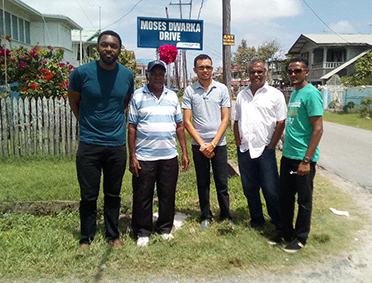History was made yesterday when the Better Hope Community honoured one of its most prominent son of the soil, Moses Dwarka, by naming a street after the ‘barefoot king.’
A modest crowd gathered at the Better Hope Community Centre, Neighbourhood Democratic Council (NDC) including Chairman, Dr. Zaman Shaw, Better Hope Sports Club President, Jainarine Singh, Director of Sports Christopher Jones, students and teachers of the Lazer Edge academic College as well as community members all celebrated the legacy that was created by their very own.
Jones, who highlighted the persistent nature of the organizers in making the event a reality, said that when the news reached the National Sports Commission, he was excited to see a community taking this step in honouring a sport revolutionary.
He related that he is expecting other communities to follow the example set and work along with the relevant authorities to have the legacy of spectacular individuals remembered.
Reminiscing on the well documented career of Dwarka, President of the Community Sports Club, Jainarine Singh, recalled how the roads would be packed with people looking to see the very best of their community compete.
Reciting a piece of literature on the great man, Singh read, “before the dew was displaced by the scorching sun the barefooted impressions revealed the passage of a lone figure long gone whilst his peers were still in deep slumber. He was not the tallest person nor was he different from any of the locals struggling in the colonial times of a sugar belt plantation or latifundia…at six miles he was unstoppable. I recall the crowd at the Public Road lining the sides from Montrose all the way to Better Hope. In the 50s and beyond ‘road race’ was a big event and it didn’t come any bigger than when Moses was running. We all wanted to see our champ in action. From a distance the shouts reached us like a Mexican Wave, “Moses in de lead”. And there he was, a slight relaxed crouch, mouth opened, sweating, barefooted, the shouts ‘Moses, Moses, Moses’ his legs responding evidenced by the stir of red dust, to the shouts and cries of the supportive and frenzied crowd. With a renewed lease of energy and burst of speed he left his competitors in his wake as they failed to muster a challenge to the silver bullet in white vest and pants.”
Singh said that it is a norm of this generation to use transportation to go anywhere while back in the era of Dwarka, it was foot power. Races would stretch from as far as Enmore, East Coast Demerara all the way to Ogle and while today there are runners who can compete, in those days, those runners did it with the minimal equipment but lots of heart.
NDC Councillor Mayodeen Razack reflected that during Dwarka’s time of competing, against the likes of Harry Prowell, George De Peana and Clem Fields among others, persons would line the roadways to catch a glimpse of the athletes in action.
The man of the day, Moses Dwarka, now 79 years took to the podium in an emotional state as he gracefully accepted the prestigious accolade.
“I ran in California, Jamaica, Trinidad, Venezuela, Suriname and all parts of the world but all my friends I used to run with dead now. Only me alive, I don’t know what God has in store for me,” Dwarka said.
Dwarka, who has a legacy of running barefooted, encouraged the younger generation to exercise, “run even if is 10, 15, 20 minutes a day it is good for the heart,” Dwarka said comparing his time as a runner to running for long distances consistently as he said “he would feel as if something was missing if he didn’t run.”
Dwarka, who resides in the first house on the corner of the newly named street, advised those in attendance to do things that they love but also practice hard, indicating that “you can’t just show up and expect to be the best, you have to dedicate yourself and train.”
During the presentation, an initiative by the stakeholders of the Lazer Edge Academic College saw students performing a poem in honor of the great man.
But who really was Moses? And what did he do? Dwarka was a man who ran for nearly 40 years but has been away from the scene for over 15 years now.
He was a kid from the sugar estates in the colonial era of British Guiana who ran to the best of his ability, pioneering the sport as he went on to represent Guyana in regional and international competitions including the Commonwealth Games and the Pan American Championship between 1959 and 1965.










